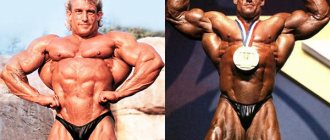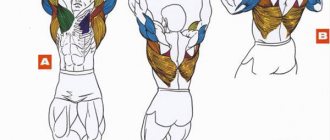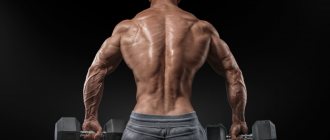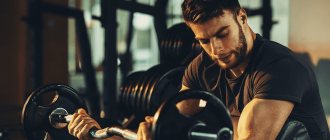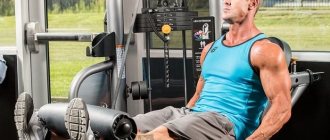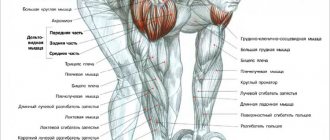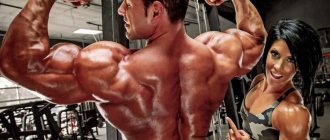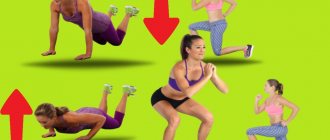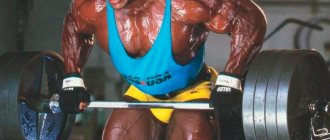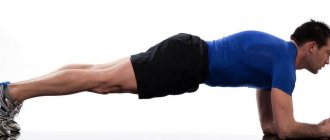For professionals and advanced bodybuilders who have already tried all the methods, but have stopped progressing, FST-7 is suitable - a training program that combines both strength training and pumping. Its essence is to lengthen and increase the elasticity of deep fascia, which fetters muscles and inhibits their growth. Why this is needed and how to train so that the muscles begin to grow faster - we will find out further.
The essence and methodology of the training
FST-7 or “fascia stretch training 7” in decoding already makes us understand that the key point in the training will be stretching or lengthening the fascia. Fascia is connective tissue that envelops all organs and muscles of the body. Like the muscles themselves, fascia tends to shorten and thicken, like inelastic rubber. Simply put, this is a kind of tourniquet for muscles that prevents muscle fibers from getting out of its limits.
Once again I will emphasize that the program is suitable for well-trained professional athletes, since beginners will not cope and even injure their muscles and fascia with rather “aggressive” training. Why aggressive:
- Firstly, the program involves strength training of certain muscle groups in the usual mode for many: 3 sets of 8-12 repetitions with maximum weight, in which 1-2 muscle groups are worked out in one workout.
- Secondly, each muscle group, after exercises performed in strength mode, performs an isolating exercise in pumping mode, that is, it completes another 7 sets of 8-15 repetitions with a minimum rest of 30-45 seconds.
Thus, an already fully loaded muscle group completes one isolating exercise to maximize the expansion and stretching of the fascia. That is, after such work, thanks to pumping, the maximum expansion of muscle fibers in volume is achieved, due to which the fascia enveloping the muscle is stretched.
During the pumping period, it is recommended to drink plenty of fluids, due to which the muscles will be filled with liquid, and accordingly, the fibers and fascia will “swell” even more.
It is important to understand that the effect of the technique is achieved only by simultaneously performing both strength training and pumping, since the muscles at the same time grow in volume and are pumped to the maximum with blood, stretching the very fascia that these muscles previously pinched.
Pros of the FST-7 training program
In addition to improving fascial health, the program helps increase overall structural flexibility of the body.
If you want to work on one specific part of the body, then the program also allows you to do this. In addition, you may reduce the overall volume of the remainder of the program due to not having time to properly rest.
Another benefit of this approach is that the high range of sets and reps will significantly stimulate your metabolism. So if your goal is to gain muscle mass or lose fat, then the results of such a workout will please you, provided that you are on the appropriate diet.
What is important when performing FST-7 training
- Do not pump at the beginning of a workout, otherwise you will pre-tire your muscles and strength work will be ineffective. Both will be useless.
- Train a large muscle group no more than once a week, and train small groups twice a week, such as your arms and calves.
- For seven sets of pumps, choose exclusively single-joint isolation exercises performed with free weights or in a machine. Basic exercises in this case will not give the same effect, since they will involve many muscles, instead of focusing on the target group.
- Rest between seven approaches should not exceed 45 seconds, in strength mode - no more than 2 minutes.
- Don't forget to drink more water.
Example training days:
- Arms and shins.
- Legs.
- Day of rest.
- Chest, triceps.
- Back, biceps.
- Shoulders, lower legs.
- Day of rest.
Basic Rules
FST-7 training aims to stretch the muscle fascia, which can interfere with muscle hypertrophy. From the name of the system you can understand what goals it pursues; you just need to decipher the abbreviation. F – fascia, S – stretching, T – training, and the number 7 indicates the number of final sets.
A little anatomy: fascia is a kind of case in which the muscle and its bundles are packed. Fascia is made up of connective tissue and is tough. Thanks to fascia, muscles have shapes that we can see in humans.
The FST-7 theory states that tight fascia acts as a limiter and prevents muscle hypertrophy, so it needs to be stretched. The more the fascia is stretched, the more muscle it can accommodate. In individuals genetically gifted for bodybuilding, the thickness of the fascia is noticeably thinner than in a less gifted person. The main tool that promotes stretching of fascia is pumping - a powerful blood supply that literally tears the muscles from the inside.
To achieve powerful pumping, FST-7 provides special approaches. The number in the title tells us about seven sets in the last exercise for the muscle group, which will allow us to fill the muscle with blood, which will ultimately lead to stretching of the fascia. But first things first.
You should not assume that the FST-7 training program is based only on pumping approaches, this is far from the case. This system includes working with heavy weights to the fullest. Therefore, working out a muscle group consists of two parts.
In the first part of the muscle group training, 2-3 basic exercises are used in 3-4 approaches. The larger the muscle group, the more exercises you can use. Weights are selected in such a way that you can perform 8-10 heavy repetitions. Before each exercise, perform 1-2 warm-up sets. The pace of performing such repetitions is standard - a slow negative phase and an explosive positive one.
After performing heavy sets, it’s time for an isolation exercise, in which you need to perform 7 sets with a rest of up to 45 seconds between sets. As a rule, the final pumping exercise uses moderate weight for 12-15 repetitions. The pace of execution is fast.
Since this is a rather traumatic training program, it is necessary to load each muscle group only once a week, not more often. Below I will give an example of one of the many FST-7 programs:
| Day 1 | Back |
| Day 2 | Deltas |
| Day 3 | Legs, abs |
| Day 4 | Chest, shin |
| Day 5 | Biceps, triceps |
| Day 6 | Rest |
| Day 7 | Rest |
Before training
I have developed an excellent algorithm for preparing for FST-7 training and I am not going to change anything about it. Before leaving the house, I drink a protein shake with skim milk with two scoops of protein powder and eat a small portion of oatmeal cooked in water. Plus I take 1000 mg of vitamin C.
Half an hour before training comes the turn of the pre-workout complex. I take a bottle of water to the gym. To survive until the end of your workout, it is extremely important to maintain an optimal level of hydration at all times. At the gym, I'll refill my water bottle and finish it before the workout ends.
I must admit, my legs were and remain the weakest link in my muscular system. When I was young, I dealt with every possible leg injury, from a knee injury on the basketball court to two broken ankles. In short, my legs have always given me a lot of problems. Of course, I continue to train my leg muscles, but I’m moving forward at a snail’s pace. The dizzying rise of working scales is not about me; I just strive to feel every muscle. So after a ten minute walk on the treadmill I'm ready to get started.
Content
- 1 FST-7 1.1 The essence of the FST-7 training program
- 1.2 Should I continue to train hard or can I just pump with light weights?
- 1.3 How often should you train each muscle group?
- 2.1 When to do “7 approaches”?
- 3.1 During training
Phase F for Quadriceps: Squats
Since this workout turned out to be the longest, I'll get straight to the point. Three sets of 12 reps with 90 seconds rest between sets.
- Set 1: weight 60 kg – 12 reps.
- Set 2: weight 85 kg – 12 reps.
- Set 3: weight 100 kg – 11 reps.
Wow, I feel a burning sensation in my muscles. I move on to the next exercise.
During training
During exercise, most people need a lot of water - about a liter. It also depends on your personality (sweating), the season and your weight. You will need more water in the summer, especially if you train in a gym that doesn't believe in air conditioning, or outside.
You can use a carbohydrate or thermogenic drink, but don't forget about plain water. If you drink one of these drinks during your workout, also take a bottle of water and alternate between them. It is worth emphasizing once again that there is no question of pumping if you do not drink enough water before and during training! As you know, our body and especially our blood are 70% water. Therefore, you should drink enough to maintain adequate fluid levels in your body.
STAGE S – DUMBBELL FLIES ON AN INCLINE BENCH
After a good contraction of the upper chest, it is necessary to bring these muscles back to their original length by bending over, stretch them and thus increase the micro tears of the muscles, which during the recovery process will become thicker and denser, thus increasing the strength and volume of the muscles.
In this exercise, the key is not the weight, but the degree of stretch, technique and feeling of the muscle. Make sure that excess weight does not turn the dumbbell curl into a regular press, otherwise the work will additionally involve the triceps, the freshness of which is important when performing the T stage.
The exercise also involves 3-4 approaches, but the number of repetitions is 12-10
1 set x 12 reps
rest – 60 seconds
2 set x 12 reps
rest – 60 seconds
3 set x 10 reps
rest - 60 seconds, after not a second of rest more, we enter stage T
Don’t forget to drink enough liquid, water should literally be next to you, after these 2 exercises with such short rest intervals, you will feel not only “clogged” muscles, but also sweat will flow in a stream, simultaneously removing important microelements.
Sets of exercises for various muscle groups
In this section I will provide various sets of exercises for specific muscle groups.
Chest muscles:
- Incline dumbbell press 4-5x8-10 (2 warm-up and 2-3 working sets)
- Dumbbell flyes on an incline bench 4-5x10 (2 warm-up and 2 working sets)
- Dumbbell press on a horizontal bench 3-5x8-10 (1-2 warm-up and 2-3 working sets)
- Information in crossover or pec-dec 7x12-15
Back muscles:
- Reverse grip lat pull-down 4x8-10 (2 warm-up and 2 working sets)
- Parallel grip lat row 2x10
- Bent-over barbell row with reverse grip 4x8-10 (2 warm-up and 2 working sets)
- Lower block thrust 3x8-10
- Pullover in block 7x12-15
Deltoids:
- Seated dumbbell press 4x8-10 (2 warm-up and 2 working sets)
- Arm abductions in the crossover 3x8-12 (1 warm-up and 2 working sets)
- Alternating lifting of dumbbells in front of you 2x8-12
- Sitting bent over superset fly-overs with overhead pull-down for rear deltoids 2x8-12
- Standing dumbbell flyes 7x12-15
Biceps:
- Standing dumbbell curls 3x8-12
- Crossover curls 3x10-12
- Reverse grip barbell raises 2x20
Triceps:
- Arm extensions in a crossover with a reverse grip 4x8-12 (2 warm-up and 2 working approaches)
- Arm extensions with dumbbells from behind the head 3x8-12 (1 warm-up and 2 working approaches)
- Extension of arms from behind the head in a crossover 7x12-15
Quadriceps:
- Back squats 5x8-10 (2 warm-up and 3 working sets)
- Leg press 5x8-10. Back squats 5x8-10 (2 warm-up and 3 working sets)
- Seated leg extensions 7x12-15
Hip flexors:
- Lying leg curls in a 5x8-12 machine (2 warm-up and 3 working approaches)
- Leg curls in a standing machine 3x10-12
- Barbell row on straight legs 4-5x8-10 (1-2 warm-up and 3 working sets)
- Lying leg curls 7x12-15
Calf muscles:
- Seated calf raises 3x12
- Toe press in a 7x15 leg press machine
As you can see, the complexes are quite rich and worth paying attention to. It is very important to remember that the indicated number of sets includes warm-up approaches, and not just working ones. Plus, all approaches are performed with increasing weight, for example, a dumbbell press on an incline bench should be performed this way:
| An approach | Weight | Repetitions | Rest between sets |
| 1 | 35kg | 12 | 1-2 min |
| 2 | 45kg | 12 | 1-2 min |
| 3 | 50kg | 10 | 2 minutes |
| 4 | 55kg | 10 | 2 minutes |
| 5 | 60kg | 8 | 2 minutes |
The final sets, designed to fill the muscles with blood and stretch the fascia, are performed in 7 sets with moderate weights. Rest between sets for up to 45 seconds, the weight in all sets is the same, without increasing or decreasing from set to set.
For beginners in FST-7, it is recommended to take single-joint exercises as final approaches, and experienced athletes can make their life more difficult by replacing them with multi-joint exercises. For example, for quads, beginners should do seven sets of seated leg extensions, while experienced ones can try leg presses or hack squats. Naturally, leg presses will be much heavier than leg extensions, and accordingly, recovery from such a load will be longer.
After training
Within 15-20 minutes after finishing your workout (or better immediately), you need to drink a shake to start the recovery process and achieve muscle growth. Either way, you can't go wrong by taking protein sources like whey protein isolate with fast-digesting carbohydrates like dextrose, maltodextrin. If you're an ectomorph hardgainer, don't be afraid to mix multiple carbohydrate sources together. You can even add fruit juice or another simple carbohydrate for flavor. If you are cutting or gaining weight quickly, limit carbohydrates.
About an hour or two after your workout, eat a meal similar in composition to what you ate before your workout. For better digestibility, try to limit fats, especially saturated fats. The time until this meal may vary depending on the size of your post-workout shake. If you drink a big shake that fills you up, it may take 2 hours before you eat.
Nutrition
I probably don't need to remind you, but I'll say it anyway: If you don't eat enough of the right foods, there is no program in the world that will help you gain quality muscle mass. But if yes, then there are some simple tricks that can help you with this.
First of all, make sure you consume more carbohydrates on arm training days. You should eat starchy, more complex carbohydrates, such as potatoes or pasta. Arm days definitely shouldn't be one of the low carb days.
Eat red meat in at least one of your meals on arm training days. Saturated and monounsaturated fats + natural creatine found in red meat will help you increase muscle strength.
Finally, if you are on a cheat meal diet, use it wisely. Plan this meal the day before your arm workout so you can load up on carbs and get ready for that workout. Eat with something like sushi or flan for dessert. You need a lot of muscle glycogen for an intense arm workout!
